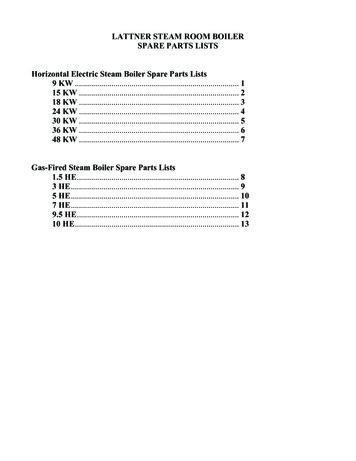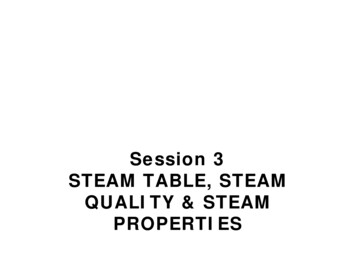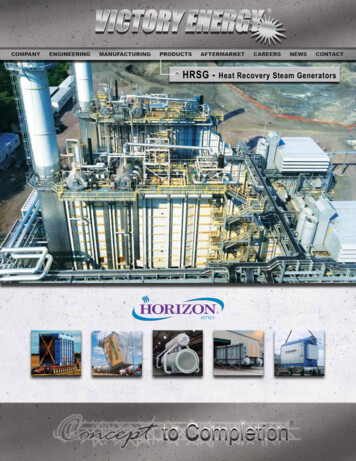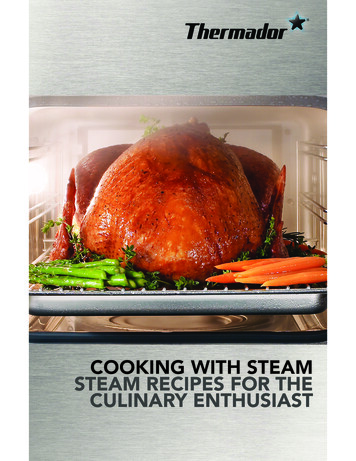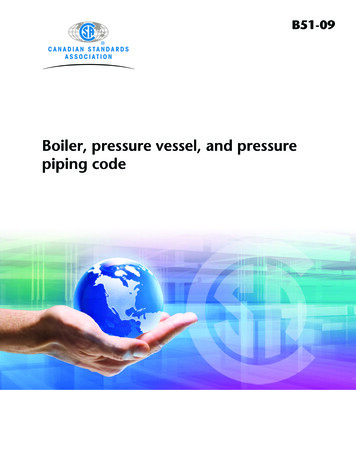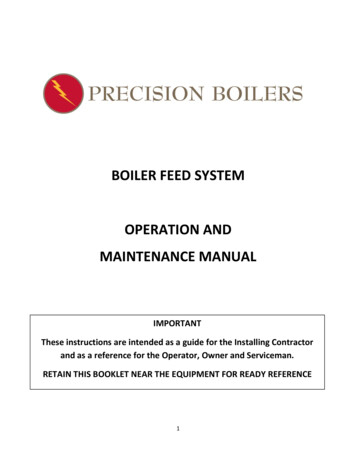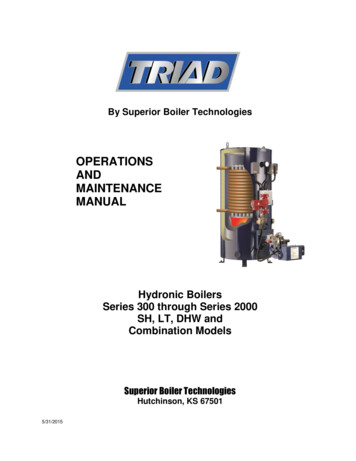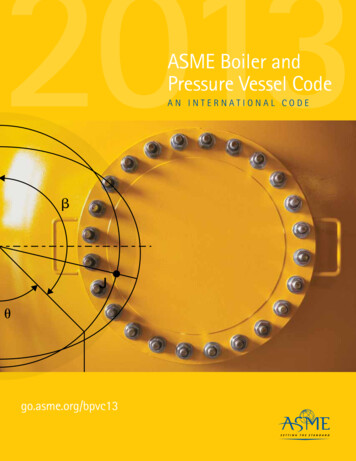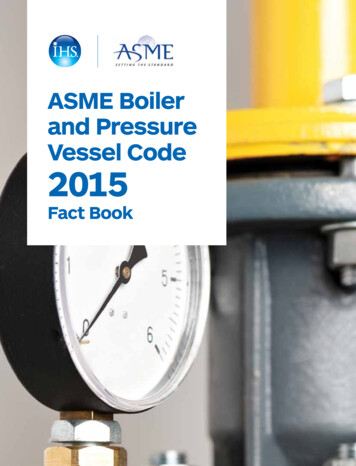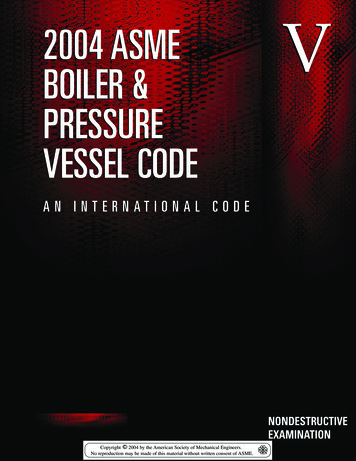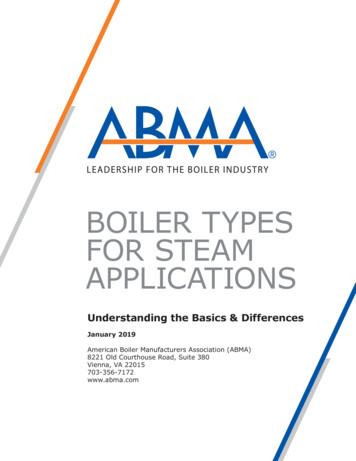
Transcription
BOILER TYPESFOR STEAMAPPLICATIONSUnderstanding the Basics & DifferencesJanuary 2019American Boiler Manufacturers Association (ABMA)8221 Old Courthouse Road, Suite 380Vienna, VA 22015703-356-7172www.abma.com
BOILER TYPES FOR STEAM APPLICATIONSACKNOWLEDGMENTABMA would like to thank Gene Tompkins on ABMA’s Technical Team for leading the creationof this publication and Jim Kolbus, Product Manager at Clark-Reliance for partnering withGene as a contributor, editor and sounding board on this publication project.This publication shares some typical advantages and disadvantages of different boiler types.While this document is not meant to address the specifics of all boilers, it should offer somegeneral opportunities for customers to select products that best suit their needs.We welcome your feedback on this publication along with ideas for future contributions fromABMA. Feel free to send any comments to info@abma.com. 2019 American Boiler Manufacturers Association2
BOILER TYPES FOR STEAM APPLICATIONSDISCLAIMERWhile this document is technically sound, it is advisory only and to be used as a guide forqualified personnel. This publication is not intended to be definitive, nor are the commentsmade regarding specific boiler types applicable to every boiler.This information is provided to help understand the common differences between boiler typesand what users should be looking for when evaluating the best boiler for their application.Any use made of the information in this publication is entirely within the control anddiscretion of the manufacturer and is wholly voluntary.ABMA expressly disclaims any responsibility for damages arising from the use, application, orreliance on the recommendations and information contained herein. 2019 American Boiler Manufacturers Association3
BOILER TYPES FOR STEAM APPLICATIONSTABLE OF CONTENTSI. Basic Boiler Types. 5II. Tradeoffs in Boiler Design. 6III. Firetube Boilers. 8IV. Watertube Boilers.11V. Economizer – The Great Equalizer.15VI. Impact of Efficiency.16VII. Historical Sales.17VIII. APPENDIX.19I. Performance Criteria.19II. An Efficiency Example.24III. Summary Comparison.26 2019 American Boiler Manufacturers Association4
BOILER TYPES FOR STEAM APPLICATIONSThis article covers the basic difference between common boiler types for high pressure steamapplications in the capacity range of 5,000,000 to 100,000,000 Btu/hr (5-100 MMBTU/hr or120 - 2400 HP). This size range would be the larger commercial, institutional and industrialapplications. This range has been selected because there are many different types of boilersavailable that are offered by several manufacturers. The goal of this paper is to provideinsights into how different boiler designs can impact the efficiency and overall operatingadvantages of a steam facility.Low-pressure steam and hot water markets are much different in both performanceopportunities and in equipment that can be used in these applications. While the generalconcepts of efficiency are the same, the actual details provide a much different environmentcompared to high-pressureI. Basic Boiler TypesThere are two basic boiler styles for steam boilers in this range, Firetube and Watertubeboilers. As their names imply, the Firetube boiler has the fire (combustion gases) inside thetube and the Watertube boiler has the water inside the tube. This allows for large variationsin product design and manufacturers have taken advantage of this to offer ever expandingoptions to customers. Over the last few years, these basic styles have expanded to include awide variety of different boilers, and with each new design comes an opportunity for a bettermatch between the different applications and boiler.FIGURE 1 – Firetube Boiler with Economizer(Courtesy of Burnham Commercial Boiler) 2019 American Boiler Manufacturers AssociationFIGURE 2 – Industrial Watertube Boiler(Courtesy of Victory Energy.)5
BOILER TYPES FOR STEAM APPLICATIONSFor this analysis, the key issues will be efficiency, response to load, ease of maintenance andspace requirements. The value of each of these considerations will vary with the application,so while some people will want to maximize the efficiency because of high fuel costs, othersmay be driven by limited space, with all other factors becoming secondary.Each product has its own list of pros and cons, and often a design is done to maximize certainattributes. There are fundamental tradeoffs in the design of a boiler, and you can cut backon one item and expand on another to offer different advantages and performance. This isexactly what has been occurring in recent decades, greatly expanding the products available.II. Tradeoffs in Boiler DesignThere are fundamental tradeoffs in the design of a boiler, and you can easily cut back on oneitem and expand on another to offer different features, cost and performance. It is importantto understand these trade-offs because you want to select the unit that will best serve yourapplication. This is not to say that some boilers will not work for your application, only thatsome boilers may work better than others. This is especially true today where there are manymore types of boilers with different advantages and performance.Here are some of the key trade-offs in boiler design;1. Adding or Reducing Heat Transfer Surface Area: All things being equal, a boiler withmore heating surface will have a higher steady state efficiency. The other advantageof larger heating surface is that if you use oil or a dirty fuel, a boiler will have a longertime between cleanings. The disadvantage of larger surface areas is that it results in alarger more expensive boiler and has a higher heat loss when the boiler cycles on and off(dynamic efficiency).2. Furnace Size: Larger furnaces are easier to fire and depending on the boiler design,it can reduce the thermal stress by lowering some temperatures (like the entranceto second pass tubes in a Firetube boiler). Furnaces size can also have an impact onthe emissions capability, with larger furnace sizes making it easier to get lower NOxemissions. A larger furnace also makes the vessel larger and more expensive. Theseconditions are not absolute, and for example, a pre-mix burner essentially needs nofurnace, which is a common design in smaller sizes and for some manufacturers. Also,the Watertube boiler typically has a larger furnace because it is relatively easy andinexpensive to do, where the Firetube furnace is usually smaller.3. Using a Pre-Mix Burner: The flame size of a pre-mix burner is a small fraction ofthe size required by a conventional burner. Because of this, a separate furnace maynot be required, and this can greatly reduce the vessel size. This technology is used inFiretube and Watertube boilers, but is more common in Watertube boilers. It also has theadvantage of offering lower emissions by simply increasing the excess air rate althoughthis tends to reduce the efficiency. Pre-mix burners are limited in gaseous fuel, such asnatural gas or propane. 2019 American Boiler Manufacturers Association6
BOILER TYPES FOR STEAM APPLICATIONS4. Improving the Heat Transfer Rate: The heat transfer rate can be improved which canincrease the efficiency, reduce the heat transfer surface or a combination of both. Thereare some common methods to do this;a. I ncreasing the flue gas velocity will directly increase the efficiency (up to a point)because more heat will be transferred to the boiler. The downside of higher velocity isthat it takes a larger fan and motor to provide this velocity.b. A dding turbulators inside the convection tubes of a Firetube boiler will improve the heattransfer, but with a higher pressure drop requiring larger fans and motors to makecapacity.c. U se tubes that have extended surface on the flue gas side. Heat transfer from the tubeto water is easy, but hard for flue gas to the tube. For a Firetube boiler, this meansnotches in the inside of the tube. In a Watertube, this could mean adding fins to theoutside of tubes. Again, all these methods will improve the heat transfer but at the costof larger fans and motors.In all of these, there is also the potential issue of plugging due to the tighter spacing andit is more difficult to clean the heat transfer surface. The extent of the difficulty dependson the type of fuel, with cleaner fuels like natural gas being less problematic.5. Adding Economizers: An economizer is a heat transfer product that will remove heatfrom the flue gas and add it to the incoming feedwater. It can save a fair amount ofenergy, and has the added benefit of working with the cooler feedwater, compared tothe hotter boiler water, so a boiler with an economizer typically has a higher steady stateefficiency. The downside to economizers is that they add cost, complexity and are subjectto cold end corrosion. 2019 American Boiler Manufacturers Association7
BOILER TYPES FOR STEAM APPLICATIONSIII. Firetube BoilersFiretube boilers have been one of the predominate boiler designs for well over a century, andeven today they represent a majority of the high pressure steam generating capacity forunits in the normal size range. Not all Firetube boilers are created the same.Historically, most manufacturers offeredScotch Marine Firetube boilers (horizontalmulti-pass with a large furnace) withthe same basic design but varied innumber of passes (2, 3 or 4-pass) orthe furnace turnaround construction(wetback or dryback). These designs hadgood track records, long life with goodefficiency and were easy to operate with aforgiving nature.The Scotch Marine Firetube boiler is madeup of a cylindrical shell that has a furnaceFIGURE 3 – 3 Pass Wetback Boiler (Courtesyto contain the combustion and numerousof Victory Energy)tubes used to extract the combustion heat.Turnaround chambers are used to reversethe combustion gases from the furnace tothe tubes, and multiple turnarounds can be used to generate multiple passes. Typical Firetubeboilers can have anything from a single pass (no furnace) to 4 passes.FIGURE 4 – 4 Pass Wetback Flue Passes(Courtesy of Cleaver-Brooks, Inc.)FIGURE 5 – 4 Pass Dryback Flue Passes(Courtesy of Cleaver-Brooks, Inc.)The flue gas turnaround from the furnace to the second pass tubes can be done in twocommon methods, a wetback and dryback turnaround. Wetback boilers have a water cooledchamber located in the vessel for the furnace turnaround and although it doesn’t requireregular maintenance, it is difficult to access for inspection, maintenance and repairs. Thedryback boiler has the furnace turnaround in a separate refractory chamber attached tothe back of the vessel, making vessel access very easy, but it can require more regularmaintenance of the gaskets and refractory. 2019 American Boiler Manufacturers Association8
BOILER TYPES FOR STEAM APPLICATIONSOne weakness of a multi-pass Firetube boiler is a problem called “Thermal Shock”. This isactually not a shock, but a difference in thermal expansion and contraction caused by thefurnace, tubes and shell heating and expanding at different rates, causing high stressesand fatigue failure. This is prevented by performing a slower warmup cycle to minimize thetemperature differences. A similar problem occurs with hot water applications, where suddenchanges in the water (return) temperature cause different expansions and contractions. Infact, multi-pass Firetube boilers are not usually used for hot water applications today becauseof this issue.A major difference between Firetube and Watertube boilers is that the Firetube boiler has amuch larger water and steam content for any given capacity. This is inherent in the designof the boiler, and the reason for most of the differences between boiler types. This largereservoir of water and steam makes the Firetube steam pressure and water level morestable in fluxuating loads. It also requires more energy to heat up to operating temperatureand pressure.THE CLASSIC SCOTCH MARINE FIRETUBE BOILERThe Scotch Marine Firetube boiler is a multi-pass horizontal boiler that typically hasthe furnace located lower in the shell. It can be 2, 3 or 4-pass with wetback or drybackconstruction. These boilers are often made with large heating surface, typically 5 square feetper boiler HP.Primary Advantages of the Scotch Marine Firetube Boiler1. Most of these boilers are built with a lot of heating surface, usually 5 square feet of heattransfer surface per boiler HP. This provides higher steady state efficiency and a goodresistance to fouling. A Watertube boiler will usually have less heat transfer surface, butoften add economizers to overcome this difference. This is why Firetube boilers typicallyhave the best steady state efficiency.2. Because a large diameter shell contains the water and steam, these boilers have a largesteam chest and disengaging area that provides good steam quality without the additionof mechanical separation.3. The furnace can be made large enough to support a variety of different fuels andemission requirements.4. The large shell space allows for a fair amount of sediment accumulation without hurtingthe vessel, providing more flexibility in water treatment and blow down maintenance. Thisis why the Firetube boiler is considered to be more forgiving.5. The large water content makes the management of water level easier to control, oftenwith just an on-off control or a simple modulating level control, adding to the “moreforgiving” concept.6. The boiler has large energy content (a combination of the steam and water at saturatedtemperature) that allows it to generate a higher steam flow rate for short periods withminimal steam pressure variations. Applications with large instantaneous flow rates canuse this advantage, but there are limits to how much can be done without hurting theboiler or creating steam quality issues, which are detrmined by the manufacturer. 2019 American Boiler Manufacturers Association9
BOILER TYPES FOR STEAM APPLICATIONS7. Most of the boiler has water or steam on the inner side of the shell, which is much coolerthan the flue gases that are on the interior of a Watertube boiler. In many cases, this canreduce the shell heat loss, defined as the “Radiation and Convection” losses.Primary Disadvantages of the Scotch Marine Firetube Boiler1. Most Scotch Marine Firetube Boilers require a slow warmup cycle that can take severalhours. Multiple pass boilers are subject to “Thermal Shock”, and if the warmup cycle isnot done properly, failures will occur over time. The larger (longer) the boiler, the biggerthe problem, because the difference of growth between the furnace, tubes and shell willbe larger.2. The longer warmup cycle often requires backup boilers to be kept hot for quickerresponse. This adds cost and complicates the operation of a plant.3. Because the steam pressure is contained by the large diameter shell, it has a limitedpressure capacity, usually around 300 PSI.4. The large steam and water content means that more energy is required to bring theunit on-line. If the boiler operates infrequently, that energy (or a portion of that startupenergy) will be lost in the off time, which is reflected in the lower dynamic efficiency.OTHER FIRETUBE BOILERSThe Scotch Marine Firetube boiler is historically the most common boiler used for steamgeneration in the size range of 5 to 75 MMBTU input. The size range of the Firetube boiler linehas been increasing over the years, and is now over 100 MMBTU/hr, or about 2500 HP. Theselarger boilers typically do not have the larger heating surface of 5 square feet/BHP, but useother means to maintain high efficiencies.There are other types of Firetube boilers, and the most common types are as follows:1. Ohio Special boilers are units made with a limited amount of heating surface. In the stateof Ohio, if the boiler has less than 358 square feet of heating surface, it does not need tohave a full-time operator, so designs are made to keep under this limit, while producing250 HP (10 MMBTU/hr input) or more. They are typically 2-pass boilers with special tubesto improve heat transfer rates.2. Firebox boilers use similar furnace and tube attachment techniques, but often do not usea round furnace or shells, and are usually limited to low pressure steam and hot water.The boiler tends to be more compact and economical and often used for seasonal heating.3. More recently, there are boilers that have less than 5 square feet of heating surface perboiler HP in a variety of wetback, dryback and number of passes. These take advantageof the improved heat transfer and the common use of natural gas to get good efficiency ina smaller package.4. There are vertical firetube boilers that offer the advantage of a much smaller footprint.These units usually are limited to about 200 HP (8,400,000 BTU/hr) in size.5. There are single-pass horizontal Firetube boilers that use a pre-mix burner and do notneed a furnace. Their primary advantage is that they don’t suffer from thermal shock,and can be brought on-line and generate steam quickly. They also have less heat transfersurface resulting in a smaller size and footprint. 2019 American Boiler Manufacturers Association10
BOILER TYPES FOR STEAM APPLICATIONSIV. Watertube BoilersWatertube boilers have numerousvariations in design, mostly because thesmall diameter tubing is easy to fabricateinto many different shapes. There aredesigns for solid fuels, smaller footprint,truck mounting, lower costs, thermal shockresistance, quick startup and other goals.The “Industrial Watertube” line is definedas units that have high capacities, highpressure capabilities and the ability toprovide superheat. Packaged IndustrialWatertube boilers typically go up to about300,000 PPH, although larger boilers arenot able to ship as complete units.FIGURE 6 – D Type Industrial Watertube Boiler(Courtesy of Babcock & Wilcox Company)Watertube boilers have the steam andwater inside the tubes, so they have much less water content than the Firetube boiler. Theyalso have a much smaller space for the collection of scale and generally require betterfeedwater because a small amount of scale can block flow through a tube.Watertube boilers are made up of multiple drums and numerous tubes. The upper drum iscalled the steam drum and the lower drums called the mud drums. The interconnecting tubesare bent to provide a furnace and convection section. The tubes may also provide some orall of the enclosure of these areas. In Bent-tube boilers, multiple gas passes are made fromthe bending of the tubes, with no attachment between the tubes, offering great resistance tothermal shock.One issue with Watertube boilers is sealing the flue gases in the vessel. This is normally donewith rigid casing (structural walls that enclose the tubes and provide a gas tight enclosure),membrane walls (tubes welded together to provide a gas tight wall) or a combination ofthese features. In addition, refractory and insulation are used to protect the drums andtube connections from the hot flue gases. There are many ways to seal the flue gases andoften these are provided as sales advantages. Welded membranes, for example, provide anexcellent means of containing the hot flue gases, but can make the vessel more rigid andsubject to thermal stresses. Tangent tubes offer flexibility in the vessel (a common trait ofBent
dryback boiler has the furnace turnaround in a separate refractory chamber attached to the back of the vessel, making vessel access very easy, but it can require more regular maintenance of the gaskets and refractory. FIGURE 3 – 3 Pass Wetback Boiler (Courtesy of Victory
